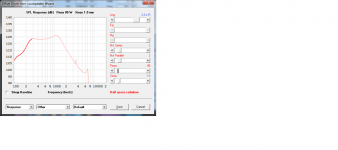This may have been covered but I cant find any references to it so here goes.
Using the spreadsheet kindly authored by Bwalso over on diysoundgroup.com I have been experimenting with flares on synergy horns.
From what I can gather the secondary flare on a horn is designed to smooth the response of the horn and reduce mouth diffraction.
My problem is that I keep getting the opposite result, case in point-
Response 1, 4 5" mids on a 50x50 deg OD horn, sizes and secondary flare as calculated by the spreadsheet.
Next, the SAME specs, but altered so that there is only a single expansion from throat to mouth, no secondary flare. Sd of the moth is the same as original, S2 has been adjusted to maintain a conical profile, see what happens?
Using the spreadsheet kindly authored by Bwalso over on diysoundgroup.com I have been experimenting with flares on synergy horns.
From what I can gather the secondary flare on a horn is designed to smooth the response of the horn and reduce mouth diffraction.
My problem is that I keep getting the opposite result, case in point-
Response 1, 4 5" mids on a 50x50 deg OD horn, sizes and secondary flare as calculated by the spreadsheet.
Next, the SAME specs, but altered so that there is only a single expansion from throat to mouth, no secondary flare. Sd of the moth is the same as original, S2 has been adjusted to maintain a conical profile, see what happens?
Attachments
Last edited:
Two Discontinuities, Instead of Just One
One in the neck, where the two flairs are joined, and the other, at the mouth.
In both places, diffraction and reflectance of the outbound wave are occurring
To reduce the magnitude these phenomena, remove edges in the neck by smoothing them and add lips to the horn mouth to make the transition to free space gradual.
Regards,
WHG
So what is going on here? Am I implementing hornresp incorrectly or is there more to it?
I have identified this phenomena over a dozen or so models and it remains consistent, any insights?
One in the neck, where the two flairs are joined, and the other, at the mouth.
In both places, diffraction and reflectance of the outbound wave are occurring
To reduce the magnitude these phenomena, remove edges in the neck by smoothing them and add lips to the horn mouth to make the transition to free space gradual.
Regards,
WHG
Last edited:
When you say the Neck, do you s3 in hornresp? Would smoothing this into s4 in more of an exponential manner result in less ripple?
What I dont get is why there is no ripple on the single flare version, and ripple on the double flare where there theoretically should be LESS!!
What I dont get is why there is no ripple on the single flare version, and ripple on the double flare where there theoretically should be LESS!!
Notes:
1) The two flare version is an acoustically smaller horn. Simulate that horn with the lips removed and see what you get.
2) Add curved lips, al la le Cleac’h to the larger single flared horn and simulate that to see what you get. The purpose of the lips is to mitigate wave diffraction and reflectance.
3) All finite horns exhibit ripple in their low frequency response due to mouth reflectance. Only when wavelength becomes comparable to or larger than horn dimensions (for both mouth and length) should ripple magnitude become acoustically important
4) You are violating the assumptions underlying the theory you are trying to apply here. As reflected by the model, the two flare horn is behaving like the bell of a tuba, where the reflectance ripple is designed to reinforce musical notes by trapping acoustical energy within the horn at certain frequencies.
Regards,
WHG
When you say the Neck, do you s3 in hornresp? Would smoothing this into s4 in more of an exponential manner result in less ripple?
What I dont get is why there is no ripple on the single flare version, and ripple on the double flare where there theoretically should be LESS!!
1) The two flare version is an acoustically smaller horn. Simulate that horn with the lips removed and see what you get.
2) Add curved lips, al la le Cleac’h to the larger single flared horn and simulate that to see what you get. The purpose of the lips is to mitigate wave diffraction and reflectance.
3) All finite horns exhibit ripple in their low frequency response due to mouth reflectance. Only when wavelength becomes comparable to or larger than horn dimensions (for both mouth and length) should ripple magnitude become acoustically important
4) You are violating the assumptions underlying the theory you are trying to apply here. As reflected by the model, the two flare horn is behaving like the bell of a tuba, where the reflectance ripple is designed to reinforce musical notes by trapping acoustical energy within the horn at certain frequencies.
Regards,
WHG
The purpose of the second flare is to avoid "waistbanding", a phenomenon in which the radiation pattern narrows to less than nominal just above the frequency where the pattern goes omni. See Keele "What's So Sacred about Exponential Horns?"
Serendipitously (is that a word? ), it also allows the horn to be a little shorter.
Serendipitously (is that a word? ), it also allows the horn to be a little shorter.
Thanks Bill, I think I get it now. Ive seen that phenomena in the polars of some horns, I think the seos 24 has some of that effect from memory.
So the ripple is less of a problem as it can be eq'd out whilst the waistbanding is not something that can be "fixed"?
Ill try a version wit an exponential second flare to see if there is any change.
Cheers, Beau.
So the ripple is less of a problem as it can be eq'd out whilst the waistbanding is not something that can be "fixed"?
Ill try a version wit an exponential second flare to see if there is any change.
Cheers, Beau.
In addition to that important feature, the second flare also makes the conical horn similar to an exponential expansion at the lower end of the frequency range, exponential horns don't roll off as steeply above the horn cut off frequency as a conical.The purpose of the second flare is to avoid "waistbanding", a phenomenon in which the radiation pattern narrows to less than nominal just above the frequency where the pattern goes omni. See Keele "What's So Sacred about Exponential Horns?"
- Status
- This old topic is closed. If you want to reopen this topic, contact a moderator using the "Report Post" button.
- Home
- Loudspeakers
- Multi-Way
- Mouth flares and their effects on horns

